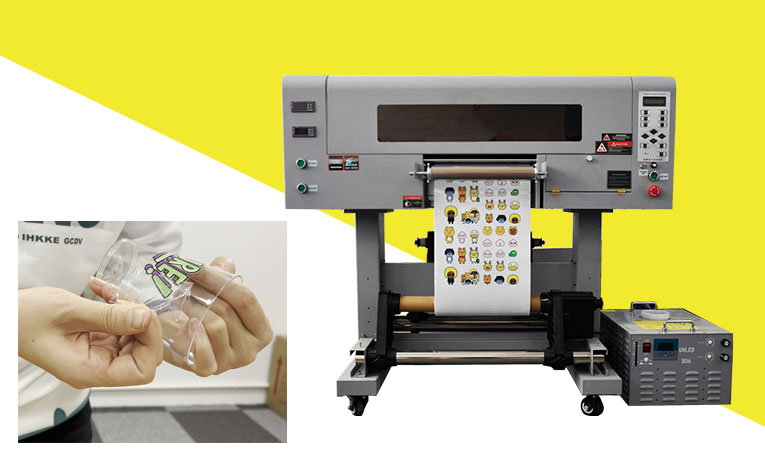UV directly printing and UV DTF printing, which one better?
UV directly printing and UV DTF printing, which one is better?
How much do you know about UV DTF printing?
UV Direct Printing
- High Durability: UV prints are highly resistant to fading, scratching, and environmental damage.
- Versatility: Suitable for a wide range of non-fabric materials, including glass, metal, plastic, and wood.
- Instant Drying: UV curing ensures prints are dry and ready for use immediately.
- Customizing mugs, phone cases, keychains, and other hard-surface items.
- Printing on metal, glass, wood, and plastic surfaces.
UV DTF Printing
- Wide Material Compatibility: UV DTF can print on a variety of materials, including fabrics, glass, metal, and plastic.
- High-Quality Prints: Produces vibrant, long-lasting prints with excellent detail and color reproduction.
- No Pre-Treatment Needed: Unlike traditional DTF, UV DTF does not require pre-treatment for dark fabrics.
- Customizing textiles, such as t-shirts, hoodies, and tote bags.
- Printing on both hard surfaces and fabrics.
Key Differences
| Feature | UV Direct Printing | UV DTF Printing |
|---|---|---|
| Material Compatibility | Hard surfaces (glass, metal, plastic, wood) | Both hard surfaces and fabrics |
| Durability | Highly durable, scratch-resistant | Durable, especially with lamination |
| Speed | Instant curing with UV light | Requires heat pressing or lamination |
| Setup Cost | Higher due to specialized UV equipment | Lower initial investment for DTF printers |
| Versatility | Limited to hard surfaces | Suitable for a wide range of materials |
| Production Volume | Great for mass production | Ideal for small-scale and custom projects |
Which One Should You Choose?
Choose UV Direct Printing If:
- You primarily need to print on hard surfaces like glass, metal, or plastic.
- You require high durability and scratch resistance.
- You are looking for a fast, efficient printing process.
Choose UV DTF Printing If:
- You want to print on a wide variety of materials, including fabrics.
- You need high-quality, vibrant prints with excellent detail.
- You are starting a custom apparel business or working with a limited budget.
Conclusion
For UV DTF printing, a particular kind of printer known as a UV flatbed printer is needed. An LED cold light source lamp used to print graphics on “A” film emits UV light that the inks are immediately exposed to. The photosensitive curing agent in the inks quickly dries when exposed to UV light.
Next, use a laminating machine to combine the “A” and “B” films. “A” film is on the back of the design, and “B” film is on the front. Afterward when, clip the design’s outline with cutters. Remove the “A” film from the design and stick it firmly to the pattern to be decorated. Peel off the “B” film after a few moments have gone. Finally, the pattern is successfully highlighted in this section. Colorful as well as unique colors are used in the prototype, which is sturdy and does not scrape off or wither away easily after being transferred.

UV Direct Printing
- High Durability: UV prints are highly resistant to fading, scratching, and environmental damage.
- Versatility: Suitable for a wide range of non-fabric materials, including glass, metal, plastic, and wood.
- Instant Drying: UV curing ensures prints are dry and ready for use immediately.
- Customizing mugs, phone cases, keychains, and other hard-surface items.
- Printing on metal, glass, wood, and plastic surfaces.
UV DTF Printing
- Wide Material Compatibility: UV DTF can print on a variety of materials, including fabrics, glass, metal, and plastic.
- High-Quality Prints: Produces vibrant, long-lasting prints with excellent detail and color reproduction.
- No Pre-Treatment Needed: Unlike traditional DTF, UV DTF does not require pre-treatment for dark fabrics.
- Customizing textiles, such as t-shirts, hoodies, and tote bags.
- Printing on both hard surfaces and fabrics.
Key Differences
| Feature | UV Direct Printing | UV DTF Printing |
|---|---|---|
| Material Compatibility | Hard surfaces (glass, metal, plastic, wood) | Both hard surfaces and fabrics |
| Durability | Highly durable, scratch-resistant | Durable, especially with lamination |
| Speed | Instant curing with UV light | Requires heat pressing or lamination |
| Setup Cost | Higher due to specialized UV equipment | Lower initial investment for DTF printers |
| Versatility | Limited to hard surfaces | Suitable for a wide range of materials |
| Production Volume | Great for mass production | Ideal for small-scale and custom projects |
Which One Should You Choose?
Choose UV Direct Printing If:
- You primarily need to print on hard surfaces like glass, metal, or plastic.
- You require high durability and scratch resistance.
- You are looking for a fast, efficient printing process.
Choose UV DTF Printing If:
- You want to print on a wide variety of materials, including fabrics.
- You need high-quality, vibrant prints with excellent detail.
- You are starting a custom apparel business or working with a limited budget.
